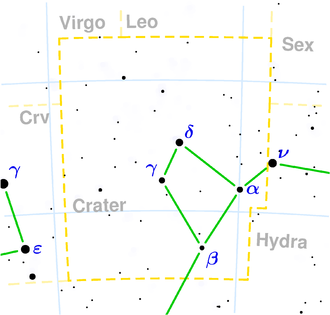Crater II dwarf galaxy
| Galaxy Crater II dwarf galaxy |
|
|---|---|
| Crater 2 | |
|
|
|
| AladinLite | |
| Constellation | cups |
|
Position equinox : J2000.0 , epoch : J2000.0 |
|
| Right ascension | 11 h 49 m 14,400 s |
| declination | -18 ° 24 ′ 46.80 ″ |
| Appearance | |
| Morphological type | dSph |
| Brightness (visual) | (20.35 ± 0.02) mag |
| Angular expansion | (62.4 ± 5.0) ′ |
| Physical data | |
| Affiliation | Local group |
| distance | (383,000 ± 3,600) ly / (117,500 ± 1,100) pc |
| Absolute brightness | (−8.2 ± 0.01) mag |
| diameter | 7000 ly |
| history | |
| discovery | VST ATLAS Survey |
| Discovery date | 2016 |
| Catalog names | |
| Very low brightness galaxy | |
The Crater II dwarf galaxy , also known as Crater II or Crater 2 for short , is a dwarf galaxy of the type dSph discovered in 2016 in the constellation Becher in the Local Group and one of the satellite galaxies of the Milky Way .
properties
It was discovered by the VST ATLAS Survey of the European Southern Observatory in Chile . It has a spheroid shape and is located approximately 390,000 light years from the solar system. The galaxy has a half-light radius of around 1100 parsecs and a diameter of 7000 light years, making it the fourth largest satellite galaxy in the Milky Way. Crater 2 is one of the most faintly glowing celestial objects ever discovered.
The University of Cambridge astronomer Gabriel Torrealba and his colleagues believe that Crater 2, like the Leo II , Leo IV, and Leo V dwarf galaxies, may have previously formed from the same star cluster .
additional
Web links
- New Scientist - Never-before-seen galaxy spotted orbiting the Milky Way (14 April 2016)
- dailymail - The 'feeble giant' lurking near the Milky Way: Previously unknown Crater 2 star cluster is spotted orbiting our galaxy (April 15, 2016)

